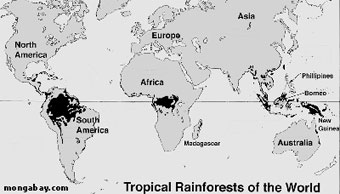Developing countries: pay us to save rainforests
Rhett A. Butler, mongabay.com
November 27, 2005 [2006 update]
At this week’s United Nations summit on climate change in Montreal a coalition of tropical developing countries plans to propose that wealthy countries pay them to preserve their rainforests. The group of 10 countries, led by Papua New Guinea and Costa Rica, will argue that they should be compensated for the services rainforests provide the rest of the world.
Burdened by poverty, the Coalition for Rainforest Nations say they cannot be expected to forfeit income from economic activities that result in deforestation, especially while other countries benefit from forest services including carbon storage, water filtration, biodiversity preservation, fisheries protection, and climate regulation. If global powers want to preserve these valuable services afforded by rainforests, then they are going to have to pay up says the Coalition, which also includes the countries of Bolivia, Central African Republic, Chile, Congo, Democratic Republic of Congo, the Dominican Republic, Guatemala and Nicaragua. These countries collectively have about 13% percent of the world’s tropical forest cover worth more than $1.1 trillion in carbon storage alone, according to 2005 figures from the UN.
“[We] are simultaneously struggling to defeat poverty while challenged with responsibility over a majority of the world’s biodiversity,” reads a statement on the web site of the Coalition Nations. “[Our] challenge is to properly align market incentives with sustainable outcomes. Never before have such nations voluntarily initiated an agenda of such scope related to rainforest management.”
“In many forested rural areas, the only real options for economic growth often require the destruction of natural forests either when clearing for agricultural commodities (like soy, coffee, tea, sugar, rice, etc) or through the sale of wood products,” continues the statement. “In effect, international markets offer perverse incentives from the perspective of environmental sustainability, biodiversity conservation, and climate stability.”
Logging, mineral extraction, clearing for subsistence and commercial agriculture, and fuelwood are critical to economies in tropical developing countries. For millions of rural inhabitants, day to day survival is dependent upon natural resource use. Most local people living in and around forests never have an option to become a doctor, factory worker, or secretary; they must live off the land that surrounds them making use of whatever resources they can find. In the long run, their poverty costs themselves, their country and the world through the loss of the biodiversity and ecosystem services like erosion prevention, flood control, water treatment, and fisheries protection.
Deforestation of tropical rainforests has a global impact through species extinction, the loss of important ecosystem services and renewable resources, and the reduction of carbon sinks. Recently a study by NASA found a direct impact that tropical deforestation has on the economies of the United States and Europe. Research shows that deforestation in the Amazon region of South America influences rainfall from Mexico to Texas and in the Gulf of Mexico, while forest loss in Central Africa affects precipitation patterns in the upper and lower U.S Midwest. Similarly, deforestation in Southeast Asia was found to influence rainfall in China and the Balkan Peninsula. Tropical deforestation also adds considerable carbon dioxide, a potent greenhouse gas, to the atmosphere. 20 to 25 percent of global carbon emissions result from changes in land use, primarily through the degradation and destruction of forests. The amount is comparable to emissions from burning fossil fuels in the US, which produces about 24 percent of global greenhouse gas emissions.
Armed with the knowledge that ecosystems in their own backyards are critical to the global economy, Coalition Nations appear to be in a good position to ask for money to conserve their rainforests. Amid growing consensus that climate change is indeed a real threat, increasing concern over catastrophic environmental events like the devastating 2005 Gulf hurricane seasons, and renewed interest in eradicating poverty, there will be considerable political pressure for wealthy countries to sit down at the bargaining table to hammer out some form of agreement that would protect rainforests in exchange for cash.
No one wants to see another Hurricane Katrina, but a warmer world could produce considerably worse storms while biological impoverishment could hold further unwanted surprises.
The following article was written earlier this year. It provides on overview on rainforest conservation issues.
Another look at global rainforest conservation
Are rainforests still in need of saving?
Editorial
Rhett Butler, mongabay.com
April 19, 2005
With Earth Day approaching it is appropriate to take another look at conservation efforts in the world’s tropical rainforests, which today are disappearing from the face of the globe. Despite growing international concern, rainforests continue to be destroyed at a pace exceeding 80,000 acres (32,000 hectares) per day. World rainforest cover now stands at around 2.5 million square miles (6 million square kilometers), an area about the size of the contiguous 48 United States or Australia and representing around 5% of the world’s land surface. Much of this remaining area has been impacted by human activities and no longer retains its full original biodiversity.
Deforestation of tropical rainforests has a global impact through species extinction, the loss of important ecosystem services and renewable resources, and the reduction of carbon sinks. However, this destruction can be slowed, stopped, and in some cases even reversed. Most people agree that the problem must be remedied, but the means are not as simple as fortifying fences around the remaining rainforests or banning the timber trade. Economic, political, and social pressures will not allow rainforests to persist if they are completely closed off from use and development
So, what should be done? The solution must be based on what is feasible, not overly idealistic, and depends on developing a new conservation policy built on the principle of sustainable use and development of rainforests. Beyond the responsible development of rainforests, efforts to rehabilitate and restore degraded forest lands along with the establishment of protected areas are key to securing rainforests for the long-term benefits they can provide mankind.
Past efforts
Historic approaches to rainforest conservation have failed as demonstrated by accelerated rate of deforestation. In many regions, closing off forests as untouchable parks and reserves has neither improved the quality of living or economic opportunities for rural poor nor deterred forest clearing by illegal loggers and developers. Corruption has only worsened the situation.
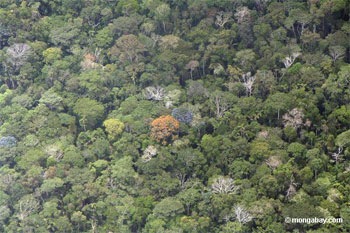 Flowering trees in the rainforest of Peru Related articles Are rainforests still worth saving? A look at why rainforests are important New deforestation figures show Nigeria has worst rate of forest loss Rainforest conservation worth the cost shows new study |
The problem with this traditional park approach to preserving wildlands in developing countries is that it fails to generate sufficient economic incentives for respecting and maintaining the forest. Rainforests will only continue to survive as functional ecosystems if they can be shown to provide tangible economic benefits. Local people and the government itself must see financial returns to justify the costs of maintaining parks and forgoing revenue from economic activities within the boundaries of the protected area.
Limited resources
Countries with significant rainforest cover are generally among the world’s poorest countries. As such, people’s day to day survival is dependent upon natural resource use. Most local people living in and around forests never have an option to become a doctor, sports star, factory worker, or secretary; they must live off the land that surrounds them making use of whatever resources they can find. Their poverty costs themselves, their country and the world through the loss of the biodiversity and ecosystem services like erosion prevention, flood control, water treatment, and fisheries protection.
Governments in these countries are in the unenviable position of having to balance the well-being of rural poor with the interests of industry, demands from foreign governments, and requirements from the international aid community. In this climate, it can be easier to simply neglect the continued destruction and degradation of environmental assets than come up with a long-term plan that ensures economic development is ecologically sustainable. Success in conserving wildlands in these countries will require reconciling the inevitable conflicts between short-term needs of local people and long-term nature of the benefits that conservation can generate on sustainable ongoing basis.
Forces behind rainforest loss
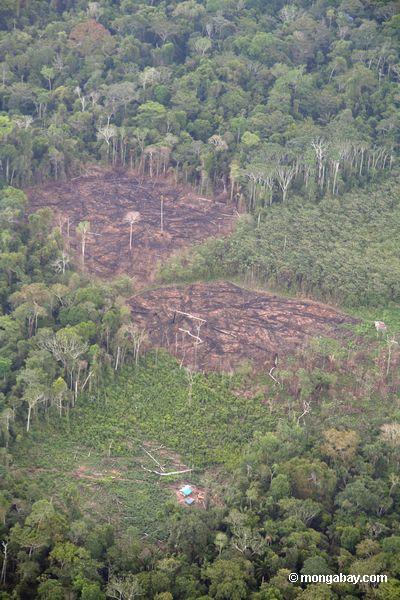 Blocks of rainforest razed for slash-and-burn agriculture in the Peruvian Amazon |
Rainforests are being cut mostly for economic reasons, though there are political and social motivations as well. A significant portion of deforestation is caused by poor farmers simply trying to eke out a living on marginal lands. Beyond conversion for subsistence agriculture, logging, clearing for cattle pasture and commercial agriculture are sizeable contributors to deforestation on a global scale. Agricultural fires typically used for land-clearing are increasingly spreading outside cultivated areas and into degraded rainforest regions.
Addressing deforestation
Addressing deforestation will need to take the very different needs and interests of these groups into account.
Poor farmers
Poor farmers are simply trying to put food on the table for their families. A better approach to addressing the needs of the rural poor may be improving and intensifying currently existing agricultural projects and promoting alternative cultivation techniques – notably permaculture. Permaculture adds a mix of crops to the farmer’s palette which both enables him to diversify his income stream and enhance degraded soils by restoring nutrients. An added benefit of such techniques is they maintain forest systems, soils, and biological diversity at a far higher level than do conventional agricultural approaches. As long as such fields are adjacent to secondary and old growth forest, many species will continue to thrive.
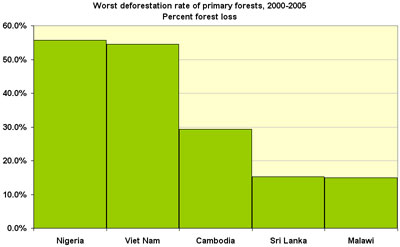 Worst deforestation rate of natural forests, 2000-2005 Credits: R. Butler |
A second important part to aiding poor farmers is helping them both gain formal title to their land. Right now, in places where it is difficult to gain ownership rights to land and land is relatively open and abundant, there is little incentive to maintain or improve holdings. Once local people have a stake in the land they are farming they will have an interest in using it efficiently instead of moving on to a new area of forest once soils are prematurely exhausted.
The creation of credit facilities for poor farmers to both save their earnings and borrow in times of need is also important to improving their quality of life. Micro-credit facilities can provide significant economic benefits to the local economy while bringing dignity to and promoting entrepreneurship among local people.
Finally improved access to markets is important in enabling farmers to get their agricultural products. Improved access can be a doubled-edged sword if it means increased road-building which often spurs further deforestation. Any infrastructure improvements should be carefully planned to minimize the future impact on remaining ecosystems.
Industrial/commercial developers
Thus far it has proved difficult applying the same permaculture agricultural techniques mentioned above to industrial operations. As currently practiced, large-scale agriculture is typically quite destructive of native ecosystems and does not maintain of biodiversity at levels commensurate to adjacent forest areas. Incremental steps like the use of natural pest control and fertilizers can help reduce pollution caused by agricultural operations while leaving strips of forest as corridors linking sections of forest helps moderate biodiversity losses.
Sustainable logging, while possible, has met resistance from the timber industry for its lack of efficiency relative to traditional harvesting methods and remains controversial among conservationists as to the impact on the environment. Illegal logging and counterfeit labeling are major obstacles facing sustainable forest management for timber but in time the development of higher yielding timber plantations will help alleviate pressures on natural forest.
Restoring and rehabilitating ecosystems
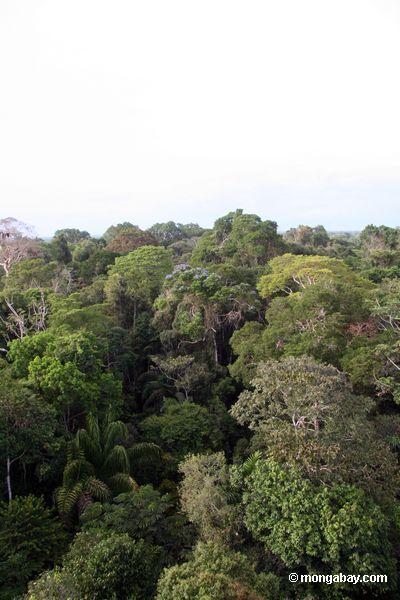 Rainforest canopy, including palm and purple flowering trees |
There is no use bemoaning past deforestation of large areas of forest. Today the concern is how to best utilize lands already cleared so they support productive activities today and for future generations. Without improving the well-being of people living in and around forests, we cannot expect rainforests to persist as fully functional systems and continue to cater to our needs.
In addressing environmental problems in rainforest countries it is important that decision makers not only be concerned with the transformation of existing natural ecosystems, but also the more rational utilization of already cleared and degraded areas. To lessen future forest loss we must increase and sustain the productivity of farms, pastures, plantations, and scrub-land in addition to restoring species and ecosystems to degraded habitats. By reducing wasteful land-use practices, consolidating gains on existing cleared lands, and improving already developed lands we can diminish the need to clear additional forest.
Research and experience has shown that the restoration of entire ecosystems is most possible in regions where parts or at least remnants of the original forest still remain and there are few human population pressures. Small clearings surrounded by forest recover quickly and large sections may recover in time especially if some assistance in the reforestation process is provided. After several years, a once barren field can once again support vegetation in the form of pioneer species and secondary growth. Although the secondary forest will be low in diversity and poorly developed, the forest cover will be adequate for some species to return (assuming they still exist). In addition, the newly forested patch can be used for the sustainable harvest of forest products and low intensity logging and agriculture.
Funding rainforest conservation efforts
Conservation efforts and sustainable development programs are not going to be cost free. Even countries that already get considerable aid from foreign donors have trouble effectively making such initiatives work in the long term. Since handouts, which in and of themselves have the tendency to breed dependency, are not going to last forever, funding these initiatives may require more creative sources of income to be truly successful. Here are some other funding strategies for consideration.
Ecotourism – Ecotourism can fund efforts both through the park entrance fees and employing locals as guides and in the service (hotels, restaurants, drivers, boat drivers, porters, cooks) and handicrafts sectors.
Bio-prospecting fees – Rainforest countries can earn revenue by allowing scientists to develop products from the island’s native plant and animal species. The pioneer in the area was Costa Rica which entered into an agreement with the American pharmaceutical company, Merck to look for plants with potential pharmaceutical applications. Under the agreement, a portion of the proceeds from compounds that do prove commercially valuable will go to the Costa Rican government which has guaranteed that some of the royalties will be set aside for conservation projects. Similarly, in 2001 Givaudan, a Swiss fragrance and flavor company, sent a team to look for new exotic smells and flavors in Madagascar. Following their survey, Givaudan researchers ‘reconstituted’ 40 aromas that could be used commercial products. The company has agreed to share a portion of the profits from these products with local communities through conservation and development initiatives.
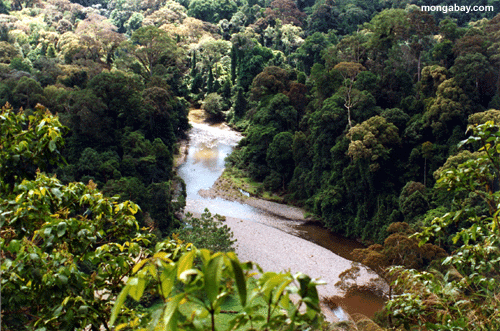 |
Carbon credits – For setting aside forest for the purpose of atmospheric carbon mitigation, developing countries can receive payments from industrialized countries looking to offset their carbon emissions. Carbon offset programs are popular in many circles since they can “provide a mechanism for motivating wealthy countries to pay for a benefit of forest conservation that transcends national borders.” In effect, such programs promote “the transfer of funds from industrialized countries to tropical countries as a commercial transaction rather than an act of charity” (Costa, P.M. “Tropical forestry practices for carbon sequestration: a review and case study from southeast Asia,” Ambio Vol. 25 No. 4, June 1996)).
Corporate sponsorship – Corporations have been a bit slow in “adopting” parks but they have the money and a marketing-driven interest in taking a closer look at such schemes. See below for more details on a potential plan.
The Linden-Lovejoy-Phillips plan – One interesting idea proposed by Eugene Linden, Thomas Lovejoy, and J. Daniel Phillips for tropical rainforests consists of dividing natural areas into blocks and then soliciting funding commitments from international environmental groups, development institutions, corporations and other credible donors. There would be a bidding process after which an entity would take responsibility for maintaining forest cover and forest health in each block of the entire forest system. This plan could be a road for corporations to become involved in conservation as a public relations/marketing tool. A given percentage of the proceeds could be put into a trust fund with the pay out ear-marked for ongoing conservation and sustainable development programs
Further steps once funding is in place
Expand protected areas – As many areas as possible should be protected. If protected areas can be developed in such a manner to generate income for local communities, an increasing number of parks should theoretically create more economic benefits for a greater share of the population.
Increase surveillance of and patrols in protected areas – This can be done a reduced cost of local communities benefit from the success of the park. If locals have a vested interest (i.e. are compensated via entrance fees, hired as guides, make handicrafts to sell to tourists, and learn to value their ecosystem for the services it can provide) they will want to watch the park to that the source of their income is not diminished. Community surveillance is the most effective way to patrol a protected area though it will probably be necessary to have park staff conduct patrols as well. Guides should be trained as well to keep watch for activities that are damaging to the ecosystem and report suspicious activities at park headquarters.
Build research facilities for training local scientists and guides – The average rainforest country needs to build its intellectual capital to grow its economy and make the best use of the country’s resources. There needs to be further studies on endemic species (many just have a name and a location and new species are being discovered every year) for both pure research reasons and potential commercial applications. Improved crop yields and reduced erosion could also be possible with future research.
Establish programs that promote sustainable use – Programs that promote sustainable use are key to elevating the standard of living for people living around protected areas. Not all members of a community will see the direct benefits from employment in the service or production sector and many people will still rely on traditional use of the natural resources around them. These resources must be used in a more effective manner to maximize productivity and minimize the impact on the environment.
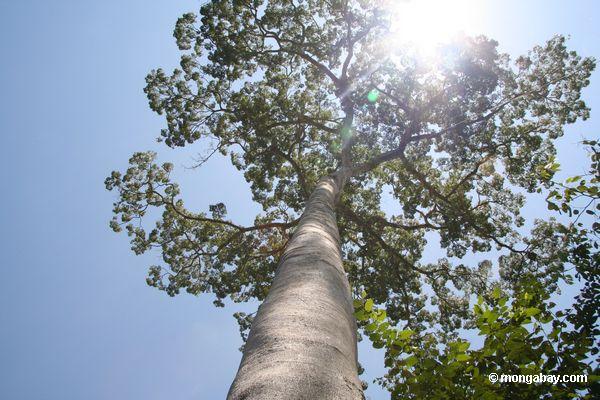 Rainforest canopy tree |
Compensate displaced people – As more protected areas are set aside it is inevitable that some people may be asked to move. It is important that these people are compensated for abandoning their existing livelihood and homes. While direct cash pay outs is an option, a better strategy is providing these displaced people with long-term income possibilities through training in better agricultural techniques or alternative crops.
Promote ecotourism – Ecotourism is perhaps the best hope for developing the economy of some rainforest countries. Planners should seek to minimize the environmental impact and maximize the benefits for local communities.
Ensure economic success does not result in increased deforestation – As rural populations begin to reap benefits from conservation-related activities it is important that they not reinvest this income in activities that result in further deforestation. Traditionally, in many villages the more money someone made, the more money that was put back into land-clearing. Rural banks and savings institutions are virtually unknown in many parts of the developing world. Such facilities, that would enable both saving and lending, could rapidly change the lives of millions through increased entrepreneurship and having the ability to put away money for the future.
Encourage entrepreneurship – Encouraging entrepreneurship through such a micro credit strategy could pay significant dividends for a country’s economy as a whole. Studies in developing countries have found that entrepreneurial skills among the poor are actually quite high when given access to capital. Default rates are typically quite low as well (do the poor have a greater respect for money). Stimulating entrepreneurship through small low-cost loans is possibly a better approach than handouts, which may do little more than breed dependency and reduce human dignity.
Looking toward the future, tough choices
Simply banning the timber trade or establishing reserves will not be enough the salvage the world’s remaining tropical rainforests. In order for the forest to be preserved, the underlying social, economic, and political reasons for deforestation must be recognized and addressed. Once the issues are brought into the light, the decision can be made what should be done. If it is decided that rainforests must be saved, then the creation of multi-use reserves that promote sustainable development and education of local people would be a good place to start. Currently about 6% of the world’s remaining forests are protected, meaning that over 90% are still open for the taking. However, even this 6% is not safe if the proper steps towards sustainable development are not taken. If possible, reforestation and restoration projects should be encouraged if we, humanity, hope to come out of this situation without serious, long-term consequences.
Forest Tables
All area figures are in hectares. All figures are derived from FAO data.
Worst deforestation rate of primary forests, 2000-2005. All countries.
| 1 | Nigeria | 55.7% | ||
| 2 | Viet Nam | 54.5% | ||
| 3 | Cambodia | 29.4% | ||
| 4 | Sri Lanka | 15.2% | ||
| 5 | Malawi | 14.9% | ||
| 6 | Indonesia | 12.9% | ||
| 7 | North Korea | 9.3% | ||
| 8 | Nepal | 9.1% | ||
| 9 | Panama | 6.7% | ||
| 10 | Guatemala | 6.4% | ||
Highest average annual deforestation of primary forests, 2000-2005, by area. Tropical countries
| 1 | Brazil | -3,466,000 | ||
| 2 | Indonesia | -1,447,800 | ||
| 3 | Mexico | -395,000 | ||
| 4 | Papua New Guinea | -250,200 | ||
| 5 | Peru | -224,600 | ||
| 6 | Bolivia | -135,200 | ||
| 7 | Sudan | -117,807 | ||
| 8 | Nigeria | -82,000 | ||
| 9 | Cambodia | -66,800 | ||
| 10 | Colombia | -56,160 | ||
| 11 | Panama | -43,200 | ||
| 12 | Malawi | -39,600 | ||
| 13 | Guatemala | -26,834 | ||
| 14 | Viet Nam | -20,400 | ||
| 15 | Democratic People’s Republic of Korea | -17,400 | ||
| 16 | French Guiana | -12,000 | ||
| 17 | Senegal | -11,000 | ||
| 18 | Nepal | -7,000 | ||
| 19 | Madagascar | -6,800 | ||
| 20 | Sri Lanka | -6,000 | ||
Most primary forest cover, 2005. Tropical countries
| 1 | Brazil | 415,890 | ||
| 2 | Peru | 61,065 | ||
| 3 | Colombia | 53,062 | ||
| 4 | Indonesia | 48,702 | ||
| 5 | Mexico | 32,850 | ||
| 6 | Bolivia | 29,360 | ||
| 7 | Papua New Guinea | 25,211 | ||
| 8 | Suriname | 14,214 | ||
| 9 | Sudan | 13,509 | ||
| 10 | Madagascar | 10,347 | ||
| 11 | Guyana | 9,314 | ||
| 12 | French Guiana | 7,701 | ||
| 13 | Congo | 7,464 | ||
| 14 | Thailand | 6,451 | ||
| 15 | Ecuador | 4,794 | ||
More figures, charts, and statistics are available at World deforestation rates and forest cover statistics, 2000-2005
